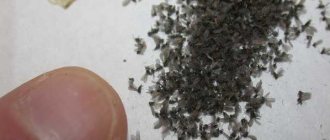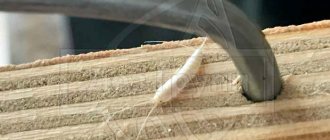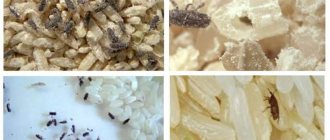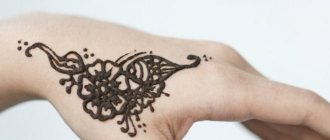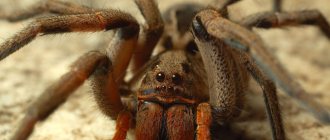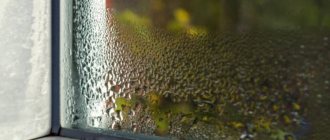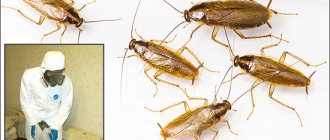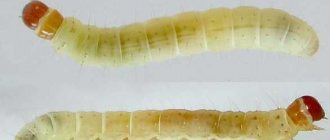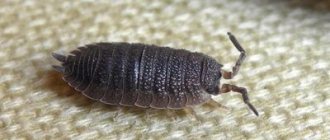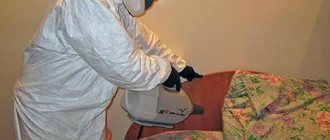The appearance of various insects in the house is difficult to predict. Sometimes neither the cleanliness of the room nor the time of year can save you from them. The skin beetle is one of these pests.
Despite the damage it can cause, not everyone knows about it, and when faced with a small bug at home, they indifferently throw away a single individual, immediately forgetting about it. Only then, having discovered bites of a strange origin or damaged things on themselves, do they begin to look for the culprit of these outrages.
Description and appearance
The skin beetle family consists of 600 species. All representatives are distinguished by their small size (1.3–12 mm). This allows it to remain invisible, especially since the dark brown, less often reddish tint of the integument blends perfectly with the environment. The oval body is covered with hairs or scales, which can form a motley pattern on the elytra.
The small head has slightly protruding eyes and short antennae.
Appearance
Wings are well developed in almost all species. Only beetles of the genus Thoriciodes and females of Thylodrias contractus are completely devoid of them.
Varieties of skin beetles
Beetles of this family can be found in all climatic zones except the tundra and arctic deserts. Accordingly, their lifestyle and diet are different. Some prefer dry matter of plant or animal origin, some prefer the corpses of insects and vertebrates, some eat only pollen.
Among the variety of skin beetles, 7 species cause the greatest harm to people:
- Floral. It feeds on nectar, leaves and flowers.
- Carpet. Settles on curtains, bed linen, carpets. Eats wool threads, pet hair, and exfoliated epidermis. May snack on leftover food.
- Kozheed Smirnova. It prefers to eat wood, so it most often lives on window sills and in furniture.
- Fur coat or fur. Contrary to its name, it eats organic matter contained in dust. Doesn't refuse human food either.
- Ham. Loves food. Larvae are often found on smoked meats, dried meats, and animal skins. They spoil books, herbariums, and zoological collections.
- Kozheed Frisch. His favorite delicacies are leather and suede products, animal products, flour and cocoa beans.
- Museum. Known as a major destroyer of rare valuables. Damages leather bindings of books and herbariums. Loves wool, fur, feathers, insect corpses.
Black carpet beetle, Attagenus unicolor Brahm.
The carpet beetle is one of the most dangerous pests of clothing and knitwear, although in general it is rarely as numerous as other carpet beetles. Almost everywhere where it settles with other species, it is replaced by its relatives. However, in its wide range (the species is distributed almost throughout the world) it finds many places where it reproduces safely without competition.
The main source of food for the carpet beetle in human housing and in various industries is fur and wool products, fluff in pillows and some bedding. Its particular danger lies in the fact that it actively damages keratin-containing materials - including feathers, down and fur, and not just the skin, as many of its family members do. In museums, it often damages stuffed animals, including birds. Sometimes its larvae settle in pillows, in felt, in woolen clothes and even in carpets, and in the latter they eat not the pile itself, but the pieces of exfoliating human skin that get stuck in it.
However, in the absence of the most preferred food, carpet beetle larvae can feed on grain products: cereals, flour, mixed feed. In this case, they greatly spoil the reserves with their excrement and the remains of chitinous coverings. As a rule, such spoiled products are thrown away at home and re-cleaned at factories, thereby losing part of the product itself and increasing its cost.
A characteristic feature of the carpet beetle is the jet-black color of the elytra, which is how it got its name. The red antennae and legs of the insect contrast strongly with this color. Its larvae are the same brown and hairy as the larvae of other types of skin beetles.
Reasons for the appearance of skin beetles in an apartment
One of the most common reasons for the appearance of a skin beetle in an apartment is when it moves on the clothes or along with the things of the future owner. After being in an infected room, it is enough to bring home several individuals and they will begin to reproduce. This pest will find food for itself in any home.
Sometimes a colony of leather beetles lives on the mezzanine or in the storage room and, during cleaning or repairs, begins to spread throughout the apartment. During the warm season, these insects can fly into an open window. Pets can also bring the pest into the house from the street. In apartment buildings, skin beetles often move away from neighbors.
Pests lead a secretive lifestyle and try not to catch the eye of people, so it is sometimes impossible to understand where they come from in an apartment.
Lifestyle
Having noticed one skin beetle, you need to be prepared for the fact that a whole colony lives in the house. The small size, the color scheme of the insect that blends with the interior, and its nocturnal activity allow the bugs to remain invisible for a long time. Only the larvae are active around the clock. Insects live in large groups and in an apartment building they can inhabit one apartment after another.
At the end of spring, the female, having laid eggs, dies. To protect the entire species from extinction, nature provided skin beetles with special fertility. One clutch can contain about 4 thousand eggs. Soon the voracious worms hatch into the world.
Larva
The peculiarity of these bugs, which love to live in apartments, is the many hairs on the larva, which gives it a shaggy appearance. Abundant nutrition allows for rapid growth. Therefore, everything that is edible goes into food. It is the larvae that cause the main damage to things and products. The next stage is pupation; it lasts 4–20 days, depending on the type of beetle and the ambient temperature.
Spotted carpet beetle Dermestes maculatus
This is one of the most famous species of skin beetles. In terms of its harmfulness, it is approximately similar to its relatives, since it feeds on meat products, leather and fur products typical of skin beetles, and exhibits in zoological collections. But thanks to its knowledge, it is actively used by people in several areas. In particular:
- Forensic experts determine the approximate time of death of a person by the number of beetles and their larvae on corpses. Here they take into account that beetles find a corpse by smell on the 5-10th day, begin to feed on its tissues themselves and lay eggs on it. And knowing the timing and chronology of the development of the larvae, and having collected these larvae on a corpse, it is possible to determine with an accuracy of up to a week the moment of death of the organism and the appearance of the corpse itself.
- At the London Natural History Museum, spotted leather beetles are specially kept in a separate room. Bones that are planned to be used to create exhibits and conduct research are also placed here - within a few weeks, the beetles and their larvae gnaw out absolutely all the tissue from these bones that can rot in the future. Ideally cleaned bones do not then need to be subjected to any special treatment that could disrupt the structure of their bone tissue. And so that not a single larva is accidentally removed from the “dermestarium”, all the bones cleaned in this way are frozen for several days, killing those insects that can remain here on the bones.
The video below shows a time lapse of a calf’s skull being cleared of soft tissue by such an army of leather beetles:
These beetles are also interesting because in nature, together with flies, they are pollinators of the foul-smelling flowers of the parasitic plant Hydnora africana. Its flowers attract corpse-eating insects precisely because of their disgusting smell, and the beetles flock to them, collecting pollen from them and transferring them to other, equally stinking flowers of this species.
And this species is also very remarkable in that it has been proven to pose a direct danger to living animals: scientists discovered adult beetles in the folds on the necks of turkeys, where skin beetles bit the birds and, in fact, gnawed off pieces of their soft tissue.
Finally, one last interesting fact: adult spotted beetle beetles are not spotted at all, but have a uniform dark brown color.
How to understand the presence and find habitats?
Since domestic skin beetles do not like noise around them, they are difficult to detect. There are three ways to understand that pests have taken up residence in your home:
- By indirect evidence. Peculiar trails gnawed by insects begin to appear on clothes, shoes, and food.
- Finding a bug or larva when it crawls very quickly across the floor. This happens if you shake it off from its usual habitat. You can distinguish it from a harmless brown worm that accidentally got into your apartment by the tuft at the end of its fluffy body that looks like a tail and its high speed of movement.
- Finding red bites on the legs or body that skin beetles leave.
At the first suspicion that a pest exists in the house, you need to carefully inspect all the places where it may be: food, kitchen cabinets, window sills, flower pots, behind baseboards, upholstery and lamp shades.
Is it dangerous for humans?
The carpet beetle does not seek to purposefully bite a person, like a bug or mosquito. Most often, this happens by accident. The wound is painful and a drop of blood may leak out. An allergic reaction causes redness and swelling.
Insects are carriers of various diseases as they eat animal remains. The main danger of a beetle bite is the risk of contracting an infection and, first of all, becoming infected with helminths. The bite of the larvae is no less dangerous.
The infection can also be transmitted to humans through products damaged by pests. They cannot be eaten even after heat treatment.
How dangerous is the skin beetle?
Having settled in a person’s home, this beetle manifests its sabotage in two forms: it damages food supplies, personal belongings, and household items and threatens the health of apartment residents.
Despite the fact that the threat to human health has not been confirmed by scientific research, scientists admit the existence of several reasons for concern for human health:
- infection with helminths is possible due to the larvae feeding on animals and plant debris;
- the spread of viral infection by beetles in the larval stage is possible;
- people susceptible to allergies may exhibit various allergic reactions to the presence of bugs in the apartment;
- Skin beetles do not suck blood, but their bites can cause skin irritation or allergies, and they themselves are quite painful. To minimize harm from an insect bite, treat the wounds with hydrogen peroxide or alcohol.
As a pest of stocks, the leather beetle can cause great economic damage due to its omnivorous nature. There is evidence of damage to cardboard, telephone cables, asbestos, plastic, building walls and agricultural vehicles. And this is in addition to their staple foods: fur, leather, books, meat products and grain.
How to get rid of skin beetles in an apartment?
Fighting skin beetles with physical methods is ineffective, since it can reduce the population, but not completely destroy the beetles. For quick results, it is best to use pesticides. If safety is paramount, then you can resort to folk recipes.
Chemical control agents
The choice of a suitable remedy for skin beetles in an apartment depends on the degree of infestation of the apartment.
Antimol
- Antimol and Dezmol tablets, placed in closets, will completely destroy pests on clothes and shoes in a few weeks.
- Powder with permethrin sprinkled under furniture, baseboards, and on the sofa will not only get rid of the skin beetle, but will also drive away moths.
- Aerosols work well against adults, but do not have a negative effect on eggs.
- Using a fumigator will drive out pests, but you will have to leave the device on for a long time.
- Concentrates are used to treat heavily contaminated premises. They will help get rid of both adults and beetle larvae in the apartment.
Folk remedies
The following products can be found in every home to help remove the skin beetle:
- Boric acid. The powder is poured into all places where the bug could potentially be located.
- Vinegar solution. Prepare in the proportion of 1 tbsp. l. products for 1 liter of water. Spray all cracks, baseboards, floors, window sills, and cabinets with a spray bottle.
- Essential oils of wormwood and lavender. You can moisten cotton pads with them and place them in furniture, corners, and other pest habitats.
Both low and high temperatures help fight skin beetles. In winter, at -10°C, things are taken outside. The bug quickly dies. Furniture, cracks in baseboards, and window sills can be treated with a steam generator.
Grain beetle Trogoderma granarium, also known as the nylon beetle
This is a very unique species, differing from its relatives in food preferences - it prefers to feed on plant foods, eating grain and its processed products. Moreover, due to the extremely high complexity of combating it, it is very widespread and causes enormous product losses in warehouses around the world.
The main feature of the grain beetle is the ability of its larvae to fall into a state close to a state of suspended animation for a period of up to several years, and then awaken and complete development. Because of this, the larvae are not always destroyed even with very thorough disinfection of the room; in this state, they can be transported across the entire planet in some cracks in boxes, in grain or in nut shells.
There are known descriptions of such massive infestations of products with grain beetles that losses in warehouses from these insects amounted to up to 70%. The larvae can turn grains and cereals, cocoa beans, copra, flour, malt and even milk powder into dust. In the absence of such food, they can feed on the corpses of mice and birds, and eat the remains of the bodies of other insects. Moreover, cases have been described in which grain beetle larvae gnawed through plastic bags, cardboard, foil, and even multi-layer paper and foil packaging in order to get to the product packaged in them.
As a result, the grain beetle today is one of the most dangerous pests of grain throughout the world and is considered a quarantine species in most countries with developed agriculture.
We encounter these beetles from time to time at some of the enterprises where we carry out treatment, but everywhere this happens in the early stages of infection, when there are relatively few pests and they can be destroyed quickly. When clients learn from our disinfectors about the presence of quarantine species at their enterprise, they immediately sign an agreement with us and we carry out further treatments with such regularity that leaves skin beetles no chance to survive here, even if after one of the treatments a few individuals remain here in a state diapause.
Treatment of carpet beetle bites
Skin beetle bites are dangerous for humans due to the infection that these insects can carry into the wound. Therefore, first of all, it is necessary to disinfect the affected area. If an allergic reaction occurs, antihistamines will help. Ice is applied to relieve pain.
If signs of inflammation appear, you should seek medical help immediately.
You can distinguish a skin beetle bite from a puncture caused by a bug by the following signs:
- The wounds from the bite of the latter are arranged in a chain, while those from the bug are single or chaotically scattered.
- The bug drinks blood only from open areas of the body. Traces of a bite from a skin beetle larva may also appear under underwear, for example, on the buttocks.
Carpet beetles: photos and distinctive features
Due to the relatively small size of the skin beetle, it can be difficult to see in detail with the naked eye, which in turn makes it difficult to identify the species that has settled in your apartment. The easiest way to do this is based on the location where the insect was found, so you can at least slightly narrow down the range of possible options.
If you find an adult specimen, knowing what skin beetles look like will help you decide; a photo of a representative of any family can be found on the Internet upon request. At the same time, the leather beetle in the photo will look much larger than even the largest individual in reality, so carefully read the description of each insect. Remember that there are no giant insects comparable to tropical ones in the Central region of Russia.
It is often difficult to distinguish skin beetles from other household parasites, in particular moths and bedbugs. However, any type of skin beetle has some characteristics that are not inherent in other insects living in the same environment as them.
- Bedbug bites look like a path and appear immediately in numerous scatterings; bites of skin beetles are rare, as they are actually random.
- Each type of skin beetle has its own size limit, but this does not mean that each individual reaches its maximum; most often the size of the beetles does not exceed 0.5-1.5 millimeters.
- An adult moth and a carpet beetle differ from each other more than a carpet beetle and a bed bug.
- The food moth is more like a butterfly, the food beetle is more like a beetle.
- The skin beetle larva is practically indistinguishable from the larva of a moth or bedbug; in all three cases, the color can vary from milky white to dirty brown.
Despite all the subtleties of the species, the same methods of extermination are used to destroy skin beetles that parasitize fabrics and materials. You can get rid of insects using insecticides or by contacting the SES. You can read more about each method and the means used here .
Calculator
Preventive measures
Preventive measures do not guarantee that the carpet beetle will not settle in the apartment, but will reduce the risk of their reproduction.
- Regular wet cleaning.
- Airing closets, drying clothes.
- Packing out-of-season items in vacuum bags.
- Seal all cracks with building mixture.
- Using mosquito netting on windows and vents.
Bags of dried wormwood or lavender, laid out on shelves in closets, hung in the pantry and near the window, will repel pests trying to get into the house.
